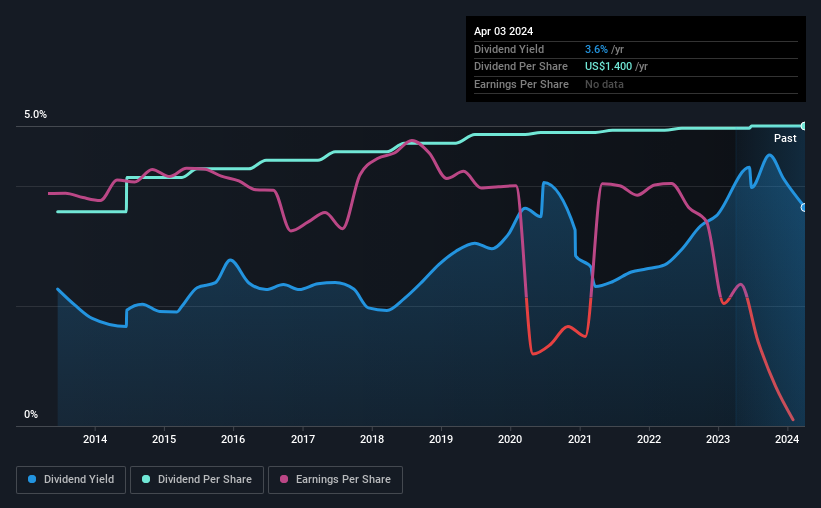Do These 3 Checks Before Buying John Wiley & Sons, Inc. (NYSE:WLY) For Its Upcoming Dividend
Regular readers will know that we love our dividends at Simply Wall St, which is why it's exciting to see John Wiley & Sons, Inc. (NYSE:WLY) is about to trade ex-dividend in the next 3 days. The ex-dividend date is usually set to be one business day before the record date which is the cut-off date on which you must be present on the company's books as a shareholder in order to receive the dividend. The ex-dividend date is of consequence because whenever a stock is bought or sold, the trade takes at least two business day to settle. Meaning, you will need to purchase John Wiley & Sons' shares before the 8th of April to receive the dividend, which will be paid on the 25th of April.
The company's next dividend payment will be US$0.35 per share, and in the last 12 months, the company paid a total of US$1.40 per share. Looking at the last 12 months of distributions, John Wiley & Sons has a trailing yield of approximately 3.6% on its current stock price of US$38.44. Dividends are a major contributor to investment returns for long term holders, but only if the dividend continues to be paid. So we need to investigate whether John Wiley & Sons can afford its dividend, and if the dividend could grow.
See our latest analysis for John Wiley & Sons
Dividends are typically paid out of company income, so if a company pays out more than it earned, its dividend is usually at a higher risk of being cut. John Wiley & Sons's dividend is not well covered by earnings, as the company lost money last year. This is not a sustainable state of affairs, so it would be worth investigating if earnings are expected to recover. Considering the lack of profitability, we also need to check if the company generated enough cash flow to cover the dividend payment. If John Wiley & Sons didn't generate enough cash to pay the dividend, then it must have either paid from cash in the bank or by borrowing money, neither of which is sustainable in the long term. It paid out more than half (55%) of its free cash flow in the past year, which is within an average range for most companies.
Click here to see how much of its profit John Wiley & Sons paid out over the last 12 months.
Have Earnings And Dividends Been Growing?
Businesses with shrinking earnings are tricky from a dividend perspective. If earnings decline and the company is forced to cut its dividend, investors could watch the value of their investment go up in smoke. John Wiley & Sons was unprofitable last year and, unfortunately, the general trend suggests its earnings have been in decline over the last five years, making us wonder if the dividend is sustainable at all.
Many investors will assess a company's dividend performance by evaluating how much the dividend payments have changed over time. In the past 10 years, John Wiley & Sons has increased its dividend at approximately 3.4% a year on average.
Remember, you can always get a snapshot of John Wiley & Sons's financial health, by checking our visualisation of its financial health, here.
Final Takeaway
Should investors buy John Wiley & Sons for the upcoming dividend? First, it's not great to see the company paying a dividend despite being loss-making over the last year. On the plus side, the dividend was covered by free cash flow." It's not the most attractive proposition from a dividend perspective, and we'd probably give this one a miss for now.
With that being said, if you're still considering John Wiley & Sons as an investment, you'll find it beneficial to know what risks this stock is facing. For example - John Wiley & Sons has 2 warning signs we think you should be aware of.
Generally, we wouldn't recommend just buying the first dividend stock you see. Here's a curated list of interesting stocks that are strong dividend payers.
Have feedback on this article? Concerned about the content? Get in touch with us directly. Alternatively, email editorial-team (at) simplywallst.com.
This article by Simply Wall St is general in nature. We provide commentary based on historical data and analyst forecasts only using an unbiased methodology and our articles are not intended to be financial advice. It does not constitute a recommendation to buy or sell any stock, and does not take account of your objectives, or your financial situation. We aim to bring you long-term focused analysis driven by fundamental data. Note that our analysis may not factor in the latest price-sensitive company announcements or qualitative material. Simply Wall St has no position in any stocks mentioned.

